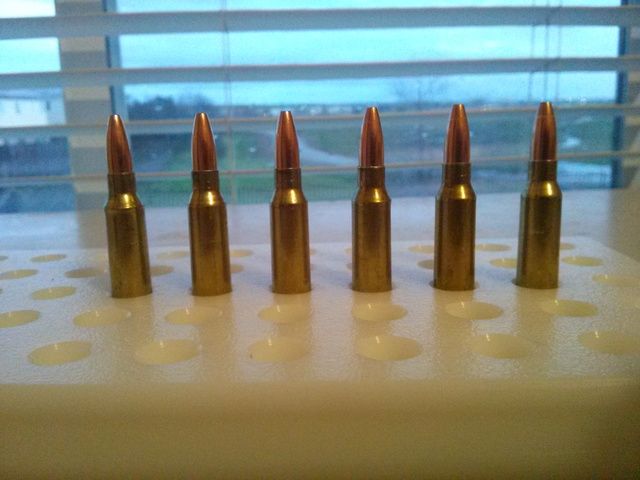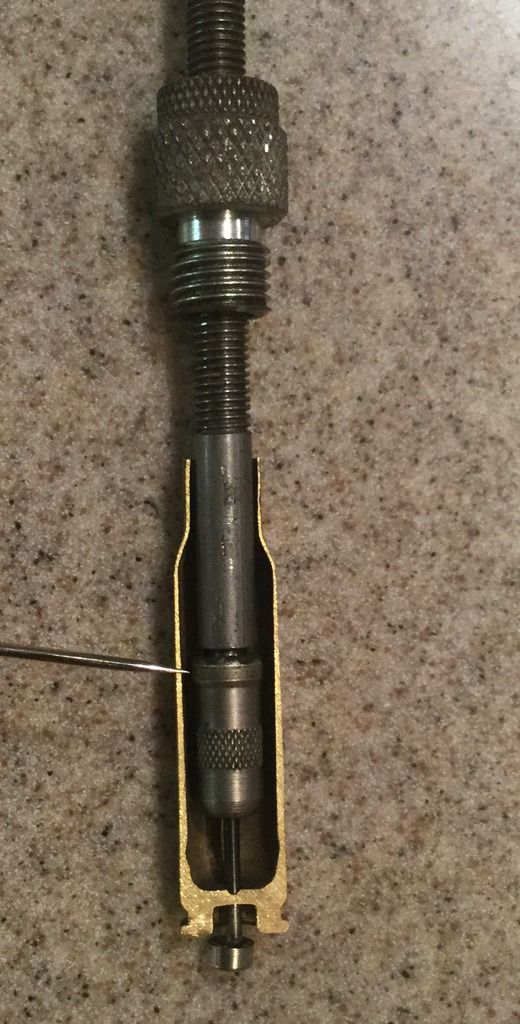Yep, I finally pushed aside the procrastination and loaded up some 223.
I had brass that had been corn cob tumbled, but that's as far as I had gone with them.
I used Hornaday's One Shot spray lube. I've heard that it can be problematic with rifle cases (works great with pistol). So I sprayed some on a paper towel and hand-applied it to the case. I had a case lube pad; but seemed to have misplaced it (found the lube for it, but no pad). I plan on getting another one, unless somebody has a better idea on how to lube 223 cases for FL sizing. I started with nine cases (I just grabbed a hand full and proceeded - that's the only reason why I chose nine).
My dies (RCBS Small Base) are brand new and uncleaned. So I had to clean them. I re-read my Speer manual on rifle loading. Set my size die and proceeded with caution. I guess stuck cases is a thing with rifle, so I moved slow. The first couple cases, I pulled them out prior to completing the press stroke and re-lubed (very lightly). They went fine. The remaining seven went faster. All went well.
I cleaned the primer pockets and then trimmed. I have one of those trimmers that fit on the end of a drill - nifty item. I was shooting for 1.750" on the trim. The closest case I had to that was 1.747 - close enough. I used it to set my trimmer. Worked great - they all trimmed to 1.747 (except for a couple that were already a little short). Chamfered and deburred. After trimming, I put them in one of those case test gauge block thingies - pass.
Ran into a problem:
I couldn't seat the bullet (dummy rounds) because the neck had no flair at all and the bullets (Sierra 55gn Blitz #1345) were square based (not boat tail). I tried a couple and managed to wreck a piece of brass - just won't seat. I have three bullet types, fortunately (also Sierra 55gn HPBT #1390; and Hornaday 55gn V-max) one of the three (Sierra 1390) was a boat tail - thankfully - so I managed to mock up a couple dummies and get my seater die set to an OAL of 2.241" (was shooting for 2.240" per Sierra - close enough). Set for a very mild crimp.
Question: I still need to know how to get the other two bullet types seated. Is there a die available that expands the case mouth? I don't want to be restricted to only boat tail bullet profiles, because I can't get the square based ones started. I feel like I'm missing something because I've been lurking for a long time and never heard of this problem. Any insight here would be a big help.
Time to prime. I primed the remaining six pieces of brass with my Lee Auto Prime and my CCI 400 primers. That went smooth - no different than the pistol brass I've been loading with a Lee Auto Prime for the last 32+ years.
Time to charge. Used AA-2230 and the starting load of 23.3 grains - per Sierra's load manual. The only hiccup here was that my large nozzle thingy on my RCBS Uniflow power hopper was too big and spilled power about. I dug out the box (32 yeas old and covered in dust) and in it was the small nozzle. Problem solved. The next six drops went perfect. Observed the powder level - check!
With the seat die already set, their trip through the press (using my 32 year old RCBS "RS-2" single stage, by the way - no Dillon progressive here) went quick and smooth. OAL = 2.241" Book spec = 2.240" - close enough. Re-tested them in the gauge block - pass.
So I have six rounds I'm going to have to test some day soon - if it ever quits raining here in northern California. Not that I'm complaining - we need the water; after five years of drought. I have two AR-15's that I built out really nice with the help of a knowledgeable friend. One, I took to the range once about a month ago - shot 57 rounds. The other is unfired. Otherwise, I have fired no other AR's. I'm not a rifle guy. This is all new to me.
I didn't write this just to ramble on (okay, maybe a little ). I'm actually looking for any insight that others might have regarding how I did. And more importantly, how I can do better. Or if you think I may have missed something, etc. Process improvements, you know. I'm normally among the journeyman here on TFL when it comes to pistol. This is something of a role-reversal. It's all good.
). I'm actually looking for any insight that others might have regarding how I did. And more importantly, how I can do better. Or if you think I may have missed something, etc. Process improvements, you know. I'm normally among the journeyman here on TFL when it comes to pistol. This is something of a role-reversal. It's all good.
Thanks for listening.

I had brass that had been corn cob tumbled, but that's as far as I had gone with them.
I used Hornaday's One Shot spray lube. I've heard that it can be problematic with rifle cases (works great with pistol). So I sprayed some on a paper towel and hand-applied it to the case. I had a case lube pad; but seemed to have misplaced it (found the lube for it, but no pad). I plan on getting another one, unless somebody has a better idea on how to lube 223 cases for FL sizing. I started with nine cases (I just grabbed a hand full and proceeded - that's the only reason why I chose nine).
My dies (RCBS Small Base) are brand new and uncleaned. So I had to clean them. I re-read my Speer manual on rifle loading. Set my size die and proceeded with caution. I guess stuck cases is a thing with rifle, so I moved slow. The first couple cases, I pulled them out prior to completing the press stroke and re-lubed (very lightly). They went fine. The remaining seven went faster. All went well.
I cleaned the primer pockets and then trimmed. I have one of those trimmers that fit on the end of a drill - nifty item. I was shooting for 1.750" on the trim. The closest case I had to that was 1.747 - close enough. I used it to set my trimmer. Worked great - they all trimmed to 1.747 (except for a couple that were already a little short). Chamfered and deburred. After trimming, I put them in one of those case test gauge block thingies - pass.
Ran into a problem:
I couldn't seat the bullet (dummy rounds) because the neck had no flair at all and the bullets (Sierra 55gn Blitz #1345) were square based (not boat tail). I tried a couple and managed to wreck a piece of brass - just won't seat. I have three bullet types, fortunately (also Sierra 55gn HPBT #1390; and Hornaday 55gn V-max) one of the three (Sierra 1390) was a boat tail - thankfully - so I managed to mock up a couple dummies and get my seater die set to an OAL of 2.241" (was shooting for 2.240" per Sierra - close enough). Set for a very mild crimp.
Question: I still need to know how to get the other two bullet types seated. Is there a die available that expands the case mouth? I don't want to be restricted to only boat tail bullet profiles, because I can't get the square based ones started. I feel like I'm missing something because I've been lurking for a long time and never heard of this problem. Any insight here would be a big help.
Time to prime. I primed the remaining six pieces of brass with my Lee Auto Prime and my CCI 400 primers. That went smooth - no different than the pistol brass I've been loading with a Lee Auto Prime for the last 32+ years.
Time to charge. Used AA-2230 and the starting load of 23.3 grains - per Sierra's load manual. The only hiccup here was that my large nozzle thingy on my RCBS Uniflow power hopper was too big and spilled power about. I dug out the box (32 yeas old and covered in dust) and in it was the small nozzle. Problem solved. The next six drops went perfect. Observed the powder level - check!
With the seat die already set, their trip through the press (using my 32 year old RCBS "RS-2" single stage, by the way - no Dillon progressive here) went quick and smooth. OAL = 2.241" Book spec = 2.240" - close enough. Re-tested them in the gauge block - pass.
So I have six rounds I'm going to have to test some day soon - if it ever quits raining here in northern California. Not that I'm complaining - we need the water; after five years of drought. I have two AR-15's that I built out really nice with the help of a knowledgeable friend. One, I took to the range once about a month ago - shot 57 rounds. The other is unfired. Otherwise, I have fired no other AR's. I'm not a rifle guy. This is all new to me.
I didn't write this just to ramble on (okay, maybe a little
Thanks for listening.



